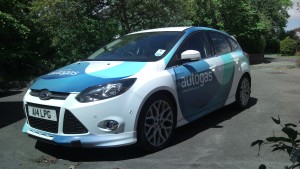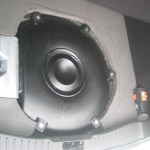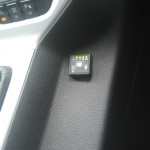 When Autogas asked us to test drive and review a Ford Focus 1.6 Ecoboost fuelled by LPG we didn’t have to think twice because the FOXY Helpdesk guys couldn’t wait to get their technical thinking caps on here and I needed to know more about the economics of this alternative and evidently green fuel.
When Autogas asked us to test drive and review a Ford Focus 1.6 Ecoboost fuelled by LPG we didn’t have to think twice because the FOXY Helpdesk guys couldn’t wait to get their technical thinking caps on here and I needed to know more about the economics of this alternative and evidently green fuel.
In a nutshell, the car starts on petrol then the LPG fuel feeds in as the engine gets warmer. This is a seamless process, explained below, allowing the much cheaper fuel to do the lion’s share of the miles.
You need two fuel tanks of course. The LPG one is fitted in the boot, instead of a spare wheel. Instead of the spare wheel you need to carry a puncture repair kit, just in case.
Apart from that, and the two fuel fillers and caps, you’d struggle to tell it was a LPG car from the exterior – although there could be no doubt about this being an Autogas vehicle from the branded Ford we drove!
As you might expect this means two fuel tanks to fill and we cover the LPG refuelling process below.
About LPG
LPG (Liquified Petroleum Gas) is familiar to most as the fuel used to operate camping stoves, barbecues and patio heaters. It’s also bulk delivered to homes that are not connected to the mains gas network. It takes liquid form when stored under pressure and becomes gaseous when released – you can see this process in action when you use a transparent disposable lighter.
When manufactured for use as vehicle fuel, LPG is often called Autogas – this is a mixture of butane and propane.
A petrol engine runs on vapour (comprising petrol and air mixed) so it will happily run on LPG as well. But LPG cannot be ‘enriched’ after first starting the engine by the likes of a choke mechanism which is either be automatic, or manual (as in pulling out the choke handle) on petrol fuelled cars. This process enables the engine to develop enough power when cold to move the car. As the engine warms up, the choke is gradually closed to compensate. Once fully warm the engine generates its maximum power.
As gas cannot be enriched, LPG cars were traditionally sluggish when cold, but modern systems have overcome that by allowing the car to start on petrol only and gradually metering the gas into the mixture as the car warms up. When warm, the car runs solely on LPG (unless it runs out when the car will switch to petrol automatically). All this is managed by the fuel controller and happens seamlessly as far as the driver is aware.
It is not technically feasible to make a diesel engine run on LPG.
How LPG works
 On the test car, the fuel is stored in a separate tank which is housed in the spare wheel aperture (see photo). There is no spare wheel; a temporary repair kit is provided instead.
On the test car, the fuel is stored in a separate tank which is housed in the spare wheel aperture (see photo). There is no spare wheel; a temporary repair kit is provided instead.
There is a small LED indicator fixed to the centre console (see below) with four LEDs which indicate the amount of LPG remaining; from four (full) to one when it is time to start looking for a filling station.
 The car started and ran well from cold and the transition from petrol to LPG was unnoticable except for an orange LED showing when it is using petrol. Other than the little indicator there is no apparent difference in the way the car looks, feels or drives; it’s just like driving a petrol Ford, just cheaper to run…
The car started and ran well from cold and the transition from petrol to LPG was unnoticable except for an orange LED showing when it is using petrol. Other than the little indicator there is no apparent difference in the way the car looks, feels or drives; it’s just like driving a petrol Ford, just cheaper to run…
How to fill up
First, find a petrol station that sells Autogas – there are more than 1400 LPG stations across the UK, one in four Shell stations is one and you can get a satnav app if need be.
They are likely to be positioned near a trunk route but this didn’t cause us any problems as we’d simply learn to plan ahead to refuel en route to motorways or coastal roads.
 When you get there, LPG is displayed on the signage (see photo).
When you get there, LPG is displayed on the signage (see photo).
The Autogas pump we used was on a filling island along with a diesel and a petrol filler nozzle. Because the LPG is stored under pressure, the nozzle has to be positively located in the filler aperture (see photo).
On the test car the aperture was let unobtrusively into the bodywork and concealed with a neat little cap.

The nozzle uses a bayonet action to fasten itself into the aperture. When (and only if) that is properly attached, it is necessary to press and hold the button on the pump until it switches off automatically or until the display shows the delivered amount of fuel you want to pay for (see photo).
On our test car the ECU calculated the remaining fuel for the petrol tank only. Autogas tell us there are moves afoot to collaborate with manufacturers to take the additional fuel type into the equation.
The LPG business case
Clearly you need to calculate the cost of converting a car to LPG alongside the likely fuel savings.
Yes, you’d save most if you’re a high mileage driver. Just factor in the cost of conversion (between £1200 to £1600 we’re told) then your fuel bill will quickly drop by some 40% on average. That’s a dramatic effect and can quickly pay back in this scenario.
There’s also the fact that the cost of the conversion depreciates much faster than the car so a three year old converted car will deliver up the fuel savings straightaway. Most employers will surely be happy to cover the conversion cost for that end result.
But you’d also save if you can make financial sense of converting a cherished older car where depreciation has long since mattered. Just spread the investment over a ten year period perhaps and work out your everyday fuel savings.
And as we all become more canny about motoring costs surely LPG needs to be taken more seriously by more motorists?
You can read all about converting your car, the benefits of LPG and how much money you can save on fuel here.
LPG’s green credentials
Looking at LPG from an air quality point of view, it is one of the cleanest fuels available, being a by-product of natural gas extraction and crude oil refining.
To be precise, Autogas CO2 emissions are up to 15 per cent lower than petrol, its NOx emissions (one of the main contributors to smog) are up to 80 per cent lower than diesel and there are up to 98 per cent fewer harmful particulates in Autogas emissions than in other fuels (Atlantic Consulting Report 2014).
FOXY’s verdict
We think LPG makes all round compelling financial and environmental sense whether you are looking for a value for money secondhand car or plan to convert your own family car.
Here is some practical advice if you are shopping for a used car, run on LPG.
Alternatively if you decide to organise your own car conversion, you should shop around carefully as some LPG converters are better than others. So far we only have one garage on our FOXY Lady Approved female friendly network (Herts Auto Tek in Knebworth) to service and repair LPG cars but the Autogas website will help you in both respects and we look forward to your feedback afterwards.
We see no reason why an LPG conversion wouldn’t add to the eventual resale value of a vehicle, after time, for compelling economic reasons.
There is no evident problem re: car insurance either, assuming you have used an approved LPG converter.
And with no perceived difference in handling, comparing petrol versus LPG drive and performance, I have no hesitation in recommending LPG as an alternative and very foxy cheap fuel for savvy women drivers. After all, some 25 million vehicles run on it around the whole world, meaning it is the third most popular automotive fuel available, for good reason.
FOXY
info@foxyladydrivers.com
@FOXYTweets

